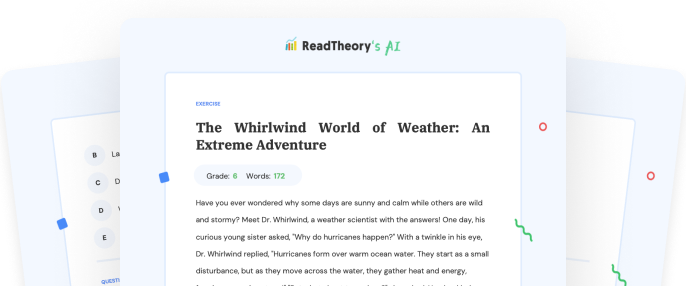Transform Your Teaching
with AI-Powered Worksheets
With ReadTheory’s Instant Worksheet Builder, you can create engaging, grade-appropriate worksheets tailored to your students in minutes. Spark curiosity, save time, and empower critical thinking with AI-powered tools designed for teachers like you.


Climate Change: Causes, Effects, and Solutions
Climate change refers to a significant and long-term alteration in weather patterns over decades, and it represents one of the most severe challenges facing our planet today. The primary cause of this phenomenon lies in the excessive release of greenhouse gases, which are primarily produced by human activities such as the burning of fossil fuels, large-scale industrial processes, and widespread deforestation. These gases form a layer in the atmosphere, trapping heat and gradually leading to a rise in global temperatures—a process widely known as global warming.
The effects of this warming are evident across the globe. For instance, the melting of polar ice caps has caused a rapid increase in sea levels, threatening the existence of coastal communities and low-lying nations. Additionally, higher temperatures have triggered more frequent and severe weather events, including prolonged heatwaves, devastating droughts, and the intensification of hurricanes due to warming ocean waters. These climatic shifts not only disrupt human life but also pose a grave danger to biodiversity. Many species are struggling to adapt to these sudden changes, and some are facing the possibility of extinction. This loss of biodiversity has a cascading impact on ecosystems, which are crucial for maintaining the balance of life on Earth.
Despite the alarming evidence of climate change, there is still hope. Around the world, individuals, organizations, and governments are working together to tackle this crisis. Efforts include transitioning to renewable energy sources like wind and solar power, which help reduce reliance on fossil fuels. Sustainable farming practices that minimize environmental damage and initiatives to promote recycling and reduce waste are gaining momentum. Public awareness campaigns and global agreements, such as the Paris Climate Accord, emphasize the need for collective action to limit global temperature rise.
Addressing climate change is a shared responsibility that requires immediate and sustained effort. By learning about the causes and consequences of this issue and taking proactive measures—whether it is by conserving energy, supporting eco-friendly policies, or planting trees—we can play a role in preserving our planet. Together, we have the power to create a more sustainable and healthier future for generations to come.
Question 1
What is the primary cause of climate change?
The Sun's heat
Tectonic plate movements
Greenhouse gases produced by human activities
Animal agriculture
Natural disasters
Question 2
What is the term for the increase in global temperatures over time due to trapped heat?
Ozone depletion
Global dimming
Climate fluctuation
Global warming
Climate inversion
Question 3
What can be a possible outcome of melting polar ice?
Increase in desert areas
Increase in sea levels
Decrease in sea levels
Increase in land mass
Decrease in humidity
Question 4
What consequences of climate change are seen in our daily lives?
Increase in world population
Decrease in technology use
Increase in fossil fuel consumption
Prolonged heatwaves and severe droughts
Decrease in job opportunities
Question 5
Which of these is a strategy to combat climate change?
Increase in fossil fuel use
Deforestation
Transitioning to renewable energy sources
Building more factories
Increase in plastic production
 or share via
or share via

Assign the ReadTheory pretest to determine students' reading levels.

Why Teachers Love
Instant Worksheet Builder?

Tailored Content for Every Student
Craft worksheets with passages and multiple-choice questions customized to your chosen topic and grade level, ensuring relevance and engagement.

Save Hours
of Prep Time
Our AI, Lexi, generates complete worksheets—passages, questions, and answers—in minutes, freeing you to focus on teaching, not planning.

Standards-Aligned Learning
Every worksheet is designed to boost reading comprehension and critical thinking, aligning seamlessly with State Standards to help your students shine.
Personalized teaching
for personalized learning
Browse worksheets created and refined by educators using Lexi—your source for inspiration and ready-to-use resources.


ReadTheory is free for Teachers to use.
Join thousands of educators using ReadTheory for free. Sign up today and start creating in just minutes!





